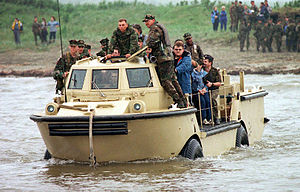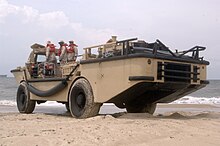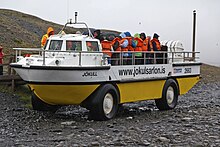LARC-V
This article includes a list of general references, but it lacks sufficient corresponding inline citations. (February 2013) |
| LARC-V | |
|---|---|
 A LARC-V vehicle | |
| Type | Amphibious cargo vehicle |
| Place of origin | |
| Production history | |
| Manufacturer | Condec, LeTourneau-Westinghouse |
| Specifications | |
| Mass | 19,000 lb (8,600 kg) |
| Length | 420 in (1,067 cm) |
| Width | 120 in (305 cm) |
| Height | 122 in (310 cm) |
| Engine | Cummins V8-300 785 cu in (12.9 L) diesel V8 300 hp (220 kW) |
| Suspension | wheel 4x4 |
Operational range | 250 mi (402.3 km) |
| Maximum speed | Land:30 mph (48 km/h) Water:9.5 mi (15.3 km) |





LARC-V (Lighter, Amphibious Resupply, Cargo, 5 ton), is an aluminium-hulled amphibious cargo vehicle capable of transporting 5 tons. It was developed in the United States during the 1950s, and is used in a variety of auxiliary roles to this day.
In addition to the United States, Larc-Vs have been used by military forces in Australia, Argentina, Portugal, The Philippines and Iceland. Approximately 968 were made. About 500 were destroyed, most by scuttling during the American withdrawal from South Vietnam. About 200 have been retained in US military service, Roughly 100 are privately owned and mostly used for tourism operators including a number of LARC vehicles is in use on Iceland for tourist trips on the Jökulsárlón ice lake and four LARC-V's used in Halifax, Nova Scotia for city and harbour tours.[1]
Operational history
LARC-Vs were used extensively by the US Army and Navy for beach supply during the Vietnam War. They supported the 101st Airborne Division in 1967 and later the 1st Cavalry Division in 1968.[2]
LARC-Vs were used by the Argentine Marines during the 1982 invasion of the Islas Malvinas.
In January 2011 during the 2010–2011 Queensland floods in Australia, Royal Australian Air Force C-17 aircraft were reported to carry two LARC-V vehicles for use in Operation Flood Assist. The vehicles were deployed from Townsville to RAAF Base Amberley.
The United States Naval Facilities Engineering Command (NAVFAC) has directed the Sealift Support Program Office (SSPO) to supervise a Service Life Extension Program (SLEP) on the LARC V's used by the Navy. This SLEP involved changing from a mechanical to a hydraulic transmission, updating the electrical system, and improving other on-board systems. These reworked LARCs began delivery in June 2006 for use by U.S. Navy Beach Master Units, Underwater Construction Teams and the Maritime Prepositioned Force ships. A total of 42 LARCs are currently funded to transition through the SLEP process.
Towing capacity on land was improved to approximately 29,000 lb and bollard pull in water was doubled to 7600 lb. The vehicle operates in all-wheel drive while in land or tow modes. The craft is powered by a 375 horsepower John Deere turbo-charged diesel engine that is Tier 2 certified. Engine speed is constant with a hydraulic transmission modifying speed.
Design and manufacture of the SLEP LARC-V's was carried out by Power Dynamics, LLC of Stennis Space Center, Mississippi.
Operators

- Australian Army
- Australian Antarctic Division (for resupply purposes to the research station on Macquarie Island)
- Jökulsárlón ehf

Specifications
- Land speed: 30 mph
- Water speed: 7.5 knots
- Capacity: 3 crew + 20 passengers (up to 10,000 lbs.)
- Maximum gradient: 60%
- Fuel capacity: 144 gallons diesel total (2 tanks)
- Unloaded land range: 280 to 335 miles
- Unloaded sea range: 110 miles
In popular culture
- Several LARC-V vehicles with Soviet markings appeared in the 2001 movie Lara Croft: Tomb Raider
- The LARC-V was featured in Modern Marvels on the History channel
See also
- DUKW
- Duck tour
- LARC-XV
- LARC-LX (BARC)
- Alvis Stalwart
References
- Doyle, David (2003). Standard catalog of U.S. Military Vehicles. Kraus Publications. pp. 250–251. ISBN 0-87349-508-X.
External links
- LARC-V at GlobalSecurity.org
